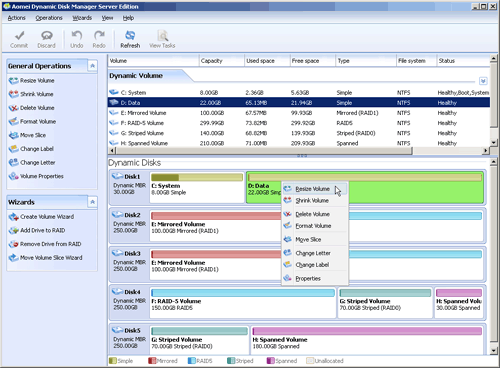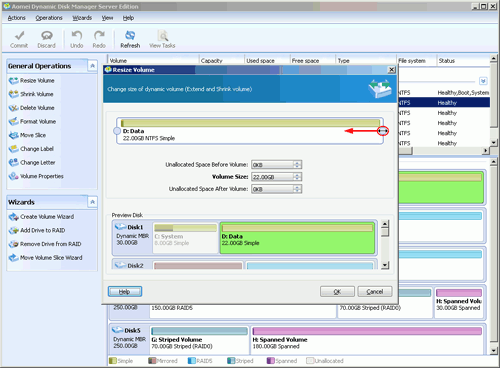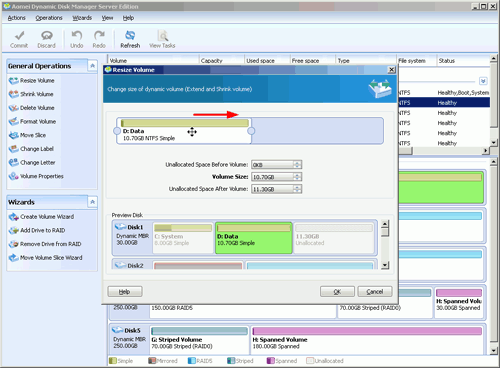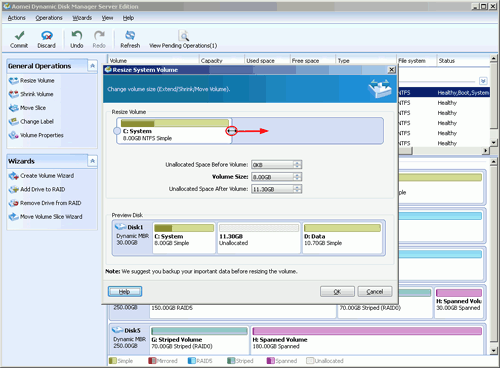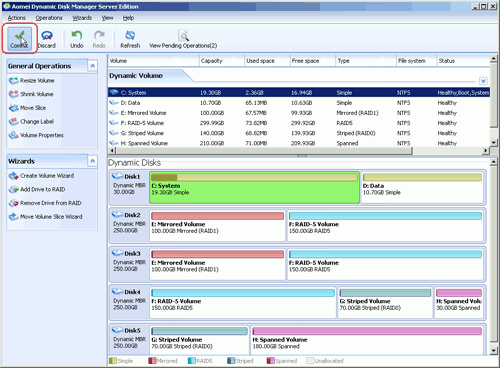How to Resize Dynamic Disk Volume without Losing Data?
This post shows detailed steps on how to resize dynamc disk volume without losing data.
✔ About dynamic disk and volumes
✔ Restrictions on resizing dynamic volume with built-in Disk Management
✔ How to resize dynamic volume with AOMEI Dynamic Disk Manager?
About dynamic disk and volumes
A dynamic disk is a physical disk that is made up of dynamic volumes, such as simple volume, spanned volume, striped volume, mirrored volume, and RAID-5 volume. The following descriptions may help you learn more about dynamic volumes:<
◆ Simple Volume: It consists of unallocated space from a single disk. You can extend a simple volume to unallocated space on the same disk or additional disks. If a simple volume is extended across multiple disks, it will become a spanned volume.
◆ Spanned Volume: It is made up of unallocated space from multiple disks. The volume size of each disk can be different. Spanned volume requires at least two disks but doesn’t provide fault tolerance, and you can use 32 disks at most.
◆ Striped Volume: It is composed of stripes of data of equal size written across each disk in the volume and created from equally sized, unallocated space on two or more physical disks. Striped volume can improve disk I/O performance but cannot offer fault tolerance. Striping is also known as RAID 0.
◆ Mirrored Volume: It is a fault-tolerant volume whose data is duplicated on two physical disks. Mirrored volumes provide data redundancy by duplicating the information contained in the volume. If one of the disks fails, the data can still be accessed from the remaining disk. Mirroring is also known as RAID 1.
◆ RAID-5 Volume: It is also a fault-tolerant volume that stripes data and parity across three or more physical disks. Parity (a calculated value that can be used to reconstruct data after a failure) is also striped across the disk array. If a physical disk fails, the portion of the RAID-5 volume that was on that failed disk can be re-created from the remaining data and the parity. RAID-5 volume only exists on computers running Windows Server Operating Systems.
Restrictions on resizing dynamic volume with built-in Disk Management
Although Windows Disk Management snap-in has the ability to resize dynamic disk, there are many limitations and the following operations cannot be completed.
◆ Extend system/boot volume in Windows 2000/XP/2003.
◆ Expand striped volume, mirrored volume, and RAID-5 volume.
In other words, you can only extend simple/spanned data volume with Disk Management.
How to resize dynamic volume with AOMEI Dynamic Disk Manager?
The "Resize Volume" feature will help you perform three kinds of operations:
◆ Free up some unallocated space by shrinking volume.
◆ Make the unallocated space behind the volume you want to extend by moving volume.
◆ Extend volume enables you to fix low disk space problem, especially for system volume.
Step 1. Open and run AOMEI Partition Assistant Server. Click the disk and choose “Dynamic Disk Manager” to move on to next interface. Then right click the D drive and select “Resize Volume”.
Step 2. In the pop-up window, drag the right slider leftwards to shrink D: volume.
Step 3. Position mouse pointer on D: volume and move it rightwards. Then, click "OK". With this method, the unallocated space has been located behind system volume.
Step 4. Right-click C: drive and select "Resize Volume". In the pop-up window, drag the right slider rightwards to extend system volume into the unallocated space. Then, click "OK".
Step5. Click "Commit" to save changes.
It is very easy and safe to resize dynamic disk volume with AOMEI Dynamic Disk Manager which also supports resizing encrypted partition, you can free download the demo version and have a try.
